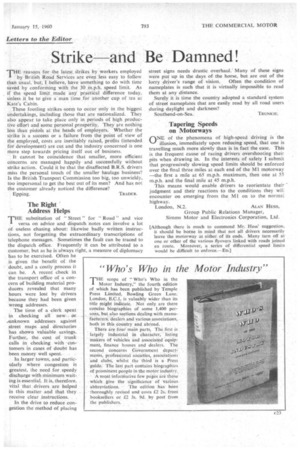Strike and Be Damned!
Page 61

If you've noticed an error in this article please click here to report it so we can fix it.
THE reasons for-the latest strikes by workers employed by British Road Services are even -less easy to follow than usual, but, I believe, have something to do with time saved by conforming with the 30 m.p.h. speed limit. As if the speed limit made any practieal difference today, unless it he to give a man time for another cup of tea at Kate's Cabin.
These footling strikes -seem to occur only in the biggest undertakings, including those that are nationalized. They also appear to take place only in periods of high productive effort and some personal prosperity. They are nothing less than pistols at the heads of employers. Whether the strike is a success or a failure from the point of view of the employed, costs are inevitably raised, profits (intended for development) are cut and the industry concerned is one more step towards pricing itself out of business.
It cannot be coincidence that smaller, more efficient concerns are managed happily and successfully without strike action. Could it be that the disaffected B.R.S. drivers miss the personal touch of the smaller haulage business? Is the British Transport Commission too big, too unwieldy, too impersonal to get the best out of its men? And has not the customer already noticed the difference?
Epping. TRADER.
The Right Address Helps
THE substitution of " Street " for "Road" and vice versa on advice and dispatch notes can involve a lot of useless chasing about: likewise badly written instruc The time of a clerk spent in checking all new or ...unknown addresses against street maps and directories has shown valuable savings.. Further, the. cost of trunk• calls in checking with customers in cases. of doubt has been money welt spent. •
In larger towns, and particularly • where congestion is greatest, the need for speedy discharge with minimum waiting is essential. It is, therefore, vital that drivers are helped in this matterand that they . receive clear instructions.
In the drive to reduce congestion the method of placing street signs needs drastic overhaul. Many of these signs were put up in the days of the horse, but are out of the lorry driver's range of vision. Often the condition of nameplates is such that it is virtually impossible to read them at any distance.
Surely it is time the country adopted a standard 'system of street nameplates that are easily read by all road users during daylight and darkness?
Southend-on-Sea. TRUNK IE.
Tapering Speeds on Motorways
rINE. of the phenomena of high-speed driving is the
illusion, immediately upon reducing speed, that one is travelling much more slowly than is infact the case. This is the frequent cause of racing drivers overshooting their pits when drawing in. In the interests of safety I submit that progressively slowing speed limits should be enforced over the final three miles at each end of the M1 motorway —the first a mile at 65 m.p.h. maximum, then one at 55 m.p.h. and the final mile at 45 mph.
This means would enable drivers to reorientate their ." judgment and their reactions to the conditions they will encounter on emerging from the M1 on to the normal highway.
London, N.2. ALAN HESS, Group Public Relations Manager, Simms Motor and Electronics Corporation, Ltd.
[Although there is much to commend Mr. Hess' suggestion, it should be borne in mind that not all drivers necessarily leave the motorway at either of its ends. Many turn off at one or other of the various flyovers linked with roads joined en route. Moreover, a series of differential speed limits would he difficult to enforce.--ED.]












































































































